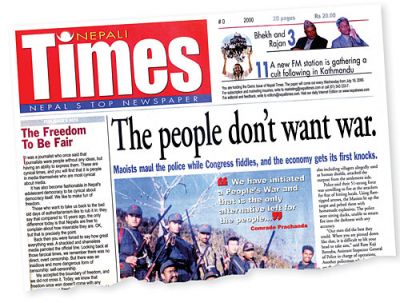 |
 |
As Nepali Times enters its tenth year, and the country enters a new year and a new decade, it is a good time to look back at the most dramatic ten years in Nepal's history.
This issue brings together some of the milestones of our recent history as seen through the pages of Nepali Times. With the benefit of hindsight, we often sound naive and innocent, sometimes cocky and idealistic. In our first editorial in 2000, we wrote:
"Nepali Times is an idea whose time has come. Newspapers do more than just hold a mirror to society. They become the mirror itself. Journalism is called history in a hurry. It is also culture, sociology, anthropology and philosophy in a hurry. Nepali Times will aspire to be a true reflection of our times: a journal to record the life and times of Nepalis in the decades ahead. A newspaper also needs a set of values to sustain itself. In a society cursed with extreme inequality, some of those values are fairly obvious: to speak for the last, the lost and the least. We will be fair, and we will protect our independence intensely."
Back in 2000, we had no idea just how dramatic the decade ahead was going to be. The first (nearly) 500 issues of this newspaper coincided with a period of great transformation. The nation was buffeted by war, traumatised by a royal massacre unprecedented in human history, witnessed a people power uprising, and saw a shaky but non-violent transition from monarchy to republic. Guerrillas went from the bullet to the ballot and emerged as the single largest party, and the most inclusive assembly in our country's history was elected.
Nepal became a model for non-violent political change: a case study that proved revolutions don't necessarily have to be bloody. And even though successive governments had no time for development, Nepalis at the grassroots endeavoured to improve lives. In the past decade, despite failed governance, Nepal's child mortality rate came down by 20 per cent, and our maternal mortality rate, though still very high, decreased dramatically. Female literacy has shot up.
Imagine how much more progress we would have made if there had been a stable political climate and a more accountable government committed to basic needs. If there had been political will to push projects for power, irrigation and infrastructure we could have met domestic demand, and created jobs so Nepalis wouldn't have to migrate for work.
Let's hope that in the next decade we will live in less interesting times. That our coverage will be less obsessed with the political quarrel of the day, and celebrate the ability of individual Nepalis to overcome adversity. We hope that by 2020 we will have made up for lost time.
Kunda Dixit
Publisher
The first decade of this newspaper coincided with the most dramatic decade in Nepal's history. Here, we give readers a journey back in time with selected material from each of the past ten years.

"We have to make a big leap..."
Interview in 2000 with Maoist Chairman Prachanda reprinted from the Revolutionary Worker.

"ke gardeko"
King Birendra released doves on his 53rd (and last) birthday on 28 December 2000 at Tundikhel. Taranath Ranabhat, parliament speaker and head of the commission of inquiry on the royal massacre, brandished at a press conference the Colt Commando rifle used by Crown Prince Dipendra. Post-massacre editorial in the Nepali Times.

Murderous middle ground
It was the civilians in the countryside who suffered the most during the conflict from atrocities by both sides.
SAGAR PANT in DANG

Offensive strategy
Columnist Puskar Gautam, a former Maoist commander for Okhaldhunga, analysed the breakdown of the second ceasefire and future Maoist strategy in this comment printed in September 2003.
PUSKAR GAUTAM

Bad blood in Beni
THOMAS BELL in BENI

Hariyo ban Nepal ko dhan
This metaphorical Nepali Times editorial after King Gyanendra's coup on 1 February 2005 tried to circumvent the military censors by replacing the word 'democracy' with 'trees'. The newspaper came out with white holes where the censors had expunged paragraphs and cartoons.

Swords into ploughshares
After ten years of war, Nepalis welcomed the end of conflict, and some Maoists realised it was more important to build than to destroy.
RAMESWOR BIHARA in SURKHET

Smouldering anger in the Madhes
A field report from the Madhes three months after the movement that changed the face of Nepal and inspired other demands for autonomy.
KUNDA DIXIT in SIRAHA

High noon at Himal
Dambar K Shrestha, Special Correspondent of Himal Khabarpatrika, recounted the attack by Maoists on 22 December 2008 in this article published in Nepali Times.
DAMBAR K SHRESTHA

Press for freeedom
As attacks on journalists continued in 2008 and 2009, Nepali Times marked Press Freedom Day on 3 May with this editorial.


